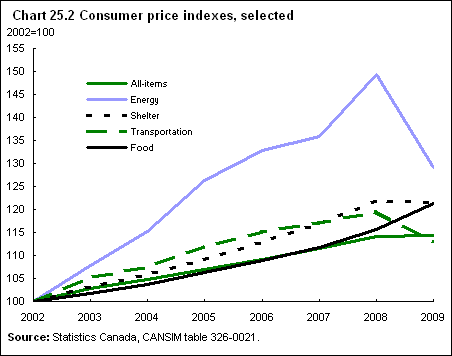Prices and price indexes
Archived Content
Information identified as archived is provided for reference, research or recordkeeping purposes. It is not subject to the Government of Canada Web Standards and has not been altered or updated since it was archived. Please "contact us" to request a format other than those available.
Related information
Changes in prices of goods and services affect how governments, businesses, and individuals spend and earn money, providing an indicator of the state of the economy. For 2009 as a whole, consumer prices as measured by the Consumer Price Index (CPI) rose 0.3%, a significantly smaller rise than the 2.3% increase in 2008 and the smallest since 1994, when prices notched up 0.1%.
Energy prices drop
Falling energy prices were the main reason for the small increase in the CPI in 2009. Overall, energy prices were 13.5% lower in 2009. Gasoline prices fell 17.5% in 2009, while prices for natural gas and for fuel oil and other fuels dropped 20.1% and 29.9%, respectively.
This followed a steady rise in the price of energy from 2002 to 2008. Consumers paid 9.9% more for energy products in 2008 than in 2007, which was substantially more than the 2.3% increase that occurred from 2006 to 2007. The increase in energy prices in 2008 was the largest since 2000, when they rose 16.2%. In 2008, higher gasoline prices were largely responsible for the rising energy costs for consumers.
In 2009, consumers' transportation costs (including costs for buying, renting, and leasing vehicles; operational and maintenance costs; public transportation costs; and gasoline) decreased 5.4%, largely as a result of falling gas prices.
Food prices increase
The pace of food price increases quickened in 2009, with a 4.9% increase, compared with a 3.5% increase in 2008. Food purchased from stores was 5.5% more expensive in 2009, while food purchased from restaurants was 3.5% more costly.
Computer equipment and supplies were considerably less expensive in 2009 with a 10.5% decrease from 2008 prices, while prices for home entertainment equipment, parts and services fell 4.4%.

View data source for chart 25.1
Shelter costs edge lower
Shelter costs edged lower by 0.3% in 2009. Decreases in shelter costs were tempered by increases in property taxes (3.4%) and in the costs to maintain and repair homes (5.8%).
In addition, the cost of household operations, furnishings, and equipment rose 2.6%. These costs include communications services, child care and domestic services, and supplies of plastic, paper and foil. Prices for furniture and household textiles rose slightly.
The Bank of Canada's core index is a variant of the consumer price index. It excludes eight of its most volatile components: fruit, vegetables, gasoline, fuel oil, natural gas, mortgage interest, intercity transportation and tobacco products. It also excludes the effect of changes in indirect taxes on the remaining components. With these components factored out, the core index increased 1.7% in 2009, the same annual increase it showed in 2008. The consumer price index, which includes the eight volatile components, increased 0.3% over the same period.
- Date modified:

